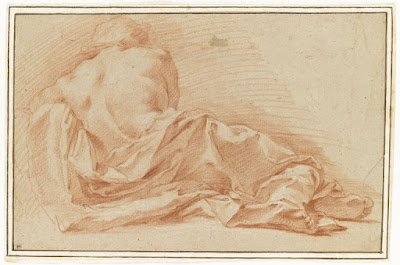 |
| Mario Balassi after Raphael Draped Figure from Parnassus fresco before 1667 drawing Musée du Louvre |
 |
| attributed to Domenico Maria Canuti Reclining Figure with Drapery before 1684 drawing Musée du Louvre |
 |
| Giulio Carpioni Study of Draped Woman before 1678 drawing Musée du Louvre |
 |
| Cavaliere d'Arpino (Giuseppe Cesari) Study of Draped Model before 1640 drawing Musée du Louvre |
 |
| Bartolomeo Cesi Youth posed with Drapery (studio garzone as model) before 1629 drawing Musée du Louvre |
 |
| Eustache Le Sueur Drapery Studies for Two Figures ca. 1645-48 drawing (study for fresco cycle, Life of St Bruno) Musée du Louvre |
 |
| Eustache Le Sueur Study of Draped Man ca. 1647 drawing (study for lost painting) Musée du Louvre |
 |
| Pierre Mignard Drapery Studies before 1695 drawing Musée du Louvre |
 |
| Pierre Mignard Drapery Studies - Seated Figures before 1695 drawing Musée du Louvre |
 |
| Pierre Mignard Drapery Studies - Sleeves before 1695 drawing Musée du Louvre |
 |
| Pierre Mignard Figure and Drapery Studies ca. 1695 drawing (study for St Luke painting the Virgin) Musée du Louvre |
 |
| Camillo Procaccini Study of Draped Figure before 1629 drawing Musée du Louvre |
 |
| Simon Vouet Drapery Studies before 1649 drawing Musée du Louvre |
 |
| Simon Vouet Drapery Study - Kneeling Figure 1649 drawing Musée du Louvre |
 |
| Simon Vouet Drapery Study - Seated Figure 1649 drawing Musée du Louvre |
 |
| Simon Vouet Study of Draped Kneeling Woman ca. 1640 drawing Musée du Louvre |
"Let the Draperies be nobly spread upon the Body; let the Folds be large, and let them follow the order of the parts, that they may be seen underneath, by means of the Lights and Shadows; notwithstanding that the parts should be often travers'd (or cross'd) by the flowing of the Folds which loosely incompass them, without sitting too straight upon them; but let them mark the parts which are under them, so as in some manner to distinguish them, by the judicious ordering of the Lights and Shadows. And if the parts be too much distant from each other, so that there be void spaces, which are deeply shadow'd, we are then to take the occasion to place in those voids some Fold to make a joining of the parts. And as the Beauty of the Limbs consists not in the quantity and rising of the Muscles, but, on the contrary, those which are less eminent have more of Majesty than the others; in the same manner the beauty of the Draperies consists not in the multitude of the folds, but in their natural order, and plain simplicity. The quality of the persons is also to be consider'd in the Drapery. As supposing them to be Magistrates, their Draperies ought to be large and ample: if Country Clowns or Slaves they ought to be course and short: if Ladies or Damsels, light and soft. 'Tis sometimes requisite to draw out, as it were from the hollows and deep shadows, some Fold, and give it a Swelling, that receiving the Light, it may contribute to extend the clearness to those places the Body requires it; and by this means we shall disburthen the piece of those hard Shadowings which are always ungracefull."
– Charles-Alphonse du Fresnoy, from The Art of Painting (1668), translated by John Dryden (1695)